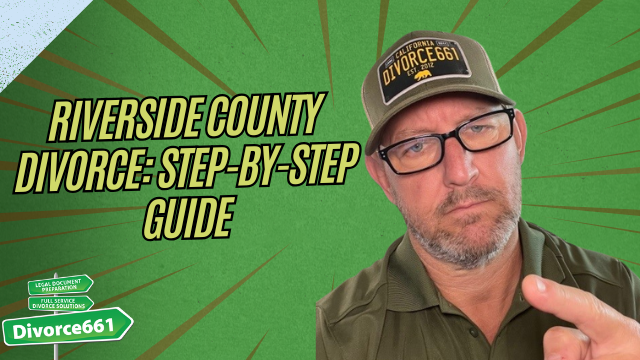Riverside County Divorce: Step-by-Step Guide
I’m Tim Blankenship from Divorce661. In my short video I walk you through the exact steps to file, serve, disclose, and finalize a divorce in Riverside County — without attorneys or courtroom appearances. Below is a clear, practical walkthrough to help you start and complete an uncontested divorce efficiently and correctly.
Overview: The basic flow
- Prepare and file the initial paperwork with Riverside Superior Court.
- Serve your spouse and file proof of service.
- Exchange mandatory financial disclosures.
- Draft and submit a Marital Settlement Agreement and judgment package (e-file when possible).
Step 1 — File the right forms
Your divorce officially starts when the court receives your paperwork. The most common forms you’ll need first are:
- Petition for Dissolution (starts the case and states what you want).
- Summons (notifies the other party there is a case).
- UCCJEA / UCCJDA (child jurisdiction form) if children are involved — this documents where the children have lived and their custody facts.
Accuracy here matters. Errors or missing information can lead to rejected filings or delays. Double-check names, dates, addresses, and case-specific info before submitting.
Step 2 — Serve your spouse correctly
Legal service is required for the case to move forward. How you serve depends on cooperation:
- If cooperative: Serving by mail is often the simplest option. Use a Notice and Acknowledgement of Receipt so your spouse can sign and return it. When they sign, you’ll file that document as proof.
- If not cooperative: You’ll need a third-party or professional process server to personally serve the documents, or use substituted service methods permitted by the court and state law.
Always file the Proof of Service with the court. This confirms the other party received notice and allows the case to proceed without unnecessary objections.
Step 3 — Exchange financial disclosures
Both parties must exchange specific financial documents, even in amicable divorces. These disclosures create transparency and protect both parties’ rights.
- Schedule of Assets and Debts — lists property, bank accounts, debts, retirement accounts, vehicles, and other assets.
- Income and Expense Declaration — details monthly income, expenses, employment, support obligations, and other financial facts.
Provide complete and accurate information. Inaccurate or incomplete disclosures are a common cause of rejection and delay. If the court or the other party rejects your disclosures, you’ll need to correct and resubmit them, which adds time and stress.
Real client example
A couple in Temecula attempted a do-it-yourself divorce but had their disclosures rejected. We corrected the paperwork and e-filed the updated documents — their divorce was approved within weeks. Precision and court-ready forms make a big difference.
Step 4 — Marital Settlement Agreement & final judgment package
Once disclosures are exchanged and any waiting periods are observed, draft a clear Marital Settlement Agreement (MSA) that covers property division, debts, support (if any), custody/visitation, and any other agreed terms.
- Make sure the MSA is signed by both parties.
- Prepare the judgment package including the judgment form and any required attachments.
- Riverside County accepts e-filing — when done correctly, e-filing speeds the process and reduces in-person court visits.
Before filing, confirm the packet is court-ready: complete forms, signatures where required, and supporting documents. Incomplete packets are frequently rejected and delay finalization.
Accurate paperwork is key.
Common pitfalls and tips to avoid delays
- Proofread every form: names, dates, addresses, and signatures must match across documents.
- Attach required supporting documents (pay stubs, bank statements, parenting class certificates if applicable).
- If serving by mail, include a self-addressed stamped envelope for the signed acknowledgment to be returned.
- Keep copies of everything you submit and file — both digital and paper.
- Use e-filing where available to speed processing, but only after confirming the packet meets the court’s requirements.
How Divorce661 helps
We offer flat-fee, full-service divorce support in Riverside County. Services include preparing and filing forms, handling service and proof of service, preparing disclosures, fixing rejected paperwork, and submitting the final judgment package — all remotely when possible.
- Flat-Fee Divorce Services — no hidden costs.
- Full-service filing, service, disclosures, and final judgment assistance.
- 100% remote support for Riverside County residents.
- Free consultation to review your case and next steps.
Next steps
- Gather essential documents (IDs, financial records, child information).
- Complete the Petition, Summons, and UCCJEA (if applicable).
- Serve your spouse and file Proof of Service.
- Exchange financial disclosures and prepare the Marital Settlement Agreement.
- File the final judgment package — use e-filing if your packet is court-ready.
Conclusion
Starting a divorce in Riverside County doesn’t have to be complicated. Follow the steps above, prioritize accurate paperwork, and avoid common mistakes that cause delays. If you’d like help, visit Divorce661.com to schedule a free consultation — we’ll review your situation and walk you through every step so you can move forward with confidence.

